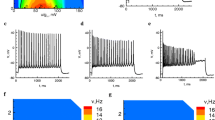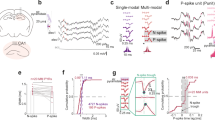Summary
Responses to current steps were recorded from pyramidal tract (PT) cells of the cat by means of intracellular microelectrodes. PT cells with resting potentials from -60 to -80 mV set up a well sustained repetitive discharge during stimulation. When comparing fast and slow PT cells, quantitative differences were found between them in the pattern of repetitive firing. Thus, (1) the rheobase is lower in slow PT cells (mean and S.D.; 0.53±0.63 nA) than in fast cells (1.57±1.11 nA). (2) Following stimulation with a current step twice rheobase the latency and the successive interspike intervals are shorter in fast PT cells than in slow cells. (3) The interspike interval distribution shows a greater irregularity in fast PT cells than in slow cells. At firing rates around 30 impulses/sec the coefficient of variation has a mean value of 0.243 for fast PT cells and 0.085 for slow cells. (4) Fast PT cells show a greater decrease of firing rate during the initial 300 msec of current stimulation (adaptation) than do slow cells. The mean value of this initial decrease is 1.85 times the later steady firing rate in fast PT cells and 0.56 times in slow cells. (5) The slope constant of the firing rate-current relationship is larger in fast PT cells, being five times or more than in slow cells. These characteristics of firing pattern are termed “kinetic” and “tonic” for fast and slow PT cells respectively, and their functional meanings are discussed in comparison with other neural organs.
Similar content being viewed by others
References
Bradley, K., Somjen, G.G.: Accommodation of motoneurones of the rat and the cat. J. Physiol. (Lond.)156, 75–92 (1961).
Buller, A.J., Nicholls, J.G., Ström, G.: Spontaneous fluctuations of excitability in the muscle spindle of the frog. J. Physiol. (Lond.)122, 409–418 (1953).
Creutzfeldt, O.D., Lux, H.D., Nacimiento, A.C.: Intracelluläre Reizung corticaler Nervenzellen. Pflügers Arch. ges. Physiol.281, 129–151 (1964).
Eccles, J.C., Eccles, R.M., Iggo, A., Ito, M.: Distribution of recurrent inhibition among motoneurones. J. Physiol. (Lond.)159, 479–499 (1961).
— —, Lundberg, A.: The action potentials of the alpha motoneurones supplying fast and slow muscles. J. Physiol. (Lond.)142, 275–291 (1958).
Eldred, P., Tokizane, T.: Two patterns of afferent discharge from muscle spindles. Amer. J. Physiol.183, 612 (1955).
Evarts, E.V.: Relation of discharge frequency to conduction velocity in pyramidal tract neurons. J. Neurophysiol.28, 216–228 (1965).
Eyzaguirre, C., Kuffler, S.W.: Processes of excitation in the dendrites and in the soma of single isolated sensory nerve cells of the lobster and crayfish. J. gen. Physiol.39, 87–119 (1955).
Frank, K., Fuortes, M.G. E.: Stimulation of spinal motoneurones with intracellular electrodes. J. Physiol. (Lond.)134, 451–470 (1956).
Fuortes, M.G.F.: Electric activity of cells in the eye of Limulus. Amer. J. Ophthal.46, 210–223 (1958).
—, Mantegazzini, F.: Interpretation of the repetitive firing of nerve cells. J. gen. Physiol.45, 1163–1179 (1962).
Granit, R., Henatsch, H.D., Steg, G.: Tonic and phasic ventral horn cells differentiated by post-tetanic potentiation in cat extensors. Acta physiol. scand.37, 114–126 (1956).
—, Kernell, D., Shortess, G.K.: Quantitative aspects of repetitive firing of mammalian motoneurones, caused by injected currents. J. Physiol. (Lond.)168, 911–931 (1963).
Granit, R., Pascoe, J.E., Steg, G.: The behaviour of tonic α and γ motoneurones during stimulation of recurrent collaterals. J. Physiol. (Lond.)138, 381–400 (1957).
—, Phillips, C.G., Skoglund, S., Steg, G.: Differentiation of tonic from phasic alpha ventral horn cells by stretch, pinna and crossed extensor reflexes. J. Neurophysiol.20, 470–481 (1957).
—, Rutledge, L.T.: Surplus excitation in reflex action of motoneurones as measured by recurrent inhibition. J. Physiol. (Lond.)154, 288–307 (1960).
Hagiwara, S.: Analysis of interval fluctuation of the sensory nerve impulse. Jap. J. Physiol.4, 234–240 (1954).
Henatsch, H.D., Schulte, F.J.: Reflexerregung und Eigenhemmung tonischer und phasischer Alpha-Motoneurone während chemischer Dauererregung der Muskelspindeln. Pflügers Arch. ges. Physiol.268, 134–147 (1958).
Henneman, E., Somjen, G., Carpenter, D.O.: Functional significance of cell size in spinal motoneurones. J. Neurophysiol.28, 560–580 (1965).
Hodgkin, A.L.: The local electric changes associated with repetitive action in a non-medullated axon. J. Physiol. (Lond.)107, 165–181 (1948).
Katsuki, Y., Yoshino, S.: Response of the single lateral-line nerve fiber to the linearly rising current stimulating the endorgan. Jap. J. Physiol.2, 219–231 (1952).
— —, Cheu, J.: Action currents of the single lateral-line nerve fiber of fish. I. On the spontaneous discharge. Jap. J. Physiol.1, 87–99 (1950).
— — —: Action current of the single lateral-line nerve fiber of fish. II. On the discharge due to stimulation. Jap. J. Physiol.1, 179–194 (1951).
Kernell, D.: The adaptation and the relation between discharge frequency and current strength of cat lumbosacral motoneurones stimulated by long-lasting injected currents. Acta physiol. scand.65, 65–73 (1965a).
—: High-frequency repetitive firing of cat lumbosacral motoneurones stimulated by long lasting injected currents. Acta physiol. scand.65, 74–86 (1965b).
—: The limits of firing frequency in cat lumbosacral motoneurones possessing different time course of after-hyperpolarization. Acta physiol. scand.65, 87–100 (1965c).
Koike, H., Okada, Y., Oshima, T.: Accommodative properties of fast and slow pyramidal tract cells and their modification by different levels of their membrane potentials. Exp. Brain Res.5, 189–201 (1968b).
— — —, Takahashi, K.: Accommodative behavior of cat pyramidal tract cells investigated with intracellular injection of currents. Exp. Brain Res.5, 173–188 (1968a).
Kuno, M.: Excitability following antidromic activation in spinal motoneurones supplying red muscles. J. Physiol. (Lond.)149, 374–393 (1959).
Lloyd, D.P.C.: Functional properties of neurons. In: Fulton, J.F. (Ed.) Howell's Textbook of Physiology (15th ed.), pp. 96–120. Philadelphia: Saunders 1946.
Matthews, P.B.C., Stein, R.B.: The regularity of primary and secondary muscle spindle afferent discharges. J. Physiol. (Lond.)202, 59–82 (1969).
Nakajima, S.: Adaptation in stretch receptor neurons of crayfish. Science146, 1168–1170 (1964).
—, Onodera, K.: Membrane properties of the stretch receptor neurones of crayfish with particular reference to mechanisms of sensory adaptation. J. Physiol. (Lond.)200, 161–185 (1969).
Nelson, P.G., Burke, R.E.: Motoneuron accommodation and motor unit twitch properties. Proc. Internat. Union Physiol. Sci.7, 316 (1968).
Oshima, T.: Studies of pyramidal tract cells. In: “Basic Mechanisms of the Epilepsies”, pp. 253–261. Ed. by H.H. Jasper, A.A. Ward, Jr. and A. Pope. Little, Brown and Co. 1969.
Pascoe, J.E.: The effects of ethyl chloride on the muscle spindles of the triceps surae of the rabbit. J. Physiol. (Lond.)180, 673–683 (1965).
Sasaki, K., Otani, T.: Accommodation in spinal motoneurons of the cat. Jap. J. Physiol.11, 443–456 (1961).
Shimazu, H., Precht, W.: Tonic and kinetic responses of cat's vestibular neurons to horizontal angular acceleration. J. Neurophysiol.28, 991–1013 (1965).
Stein, R.B.: A theoretical analysis of neuronal variability. Biophys. J.5, 173–194 (1965).
Takahashi, K.: Slow and fast groups of pyramidal tract cells and their respective membrane properties. J. Neurophysiol.28, 908–924 (1965).
—, Kubota, K., Uno, M.: Recurrent facilitation in cat pyramidal tract cells. J. Neurophysiol.30, 22–34 (1967).
Tokizane, T., Shimazu, H.: Functional differentiation of Human Skeletal Muscle. Tokyo: University of Tokyo Press 1964.
Werner, W., Mountcastle, V.B.: The variability of central neural activity in a sensory system, and its implications for the central reflection of sensory events. J. Neurophysiol.26, 958–977 (1963).
Author information
Authors and Affiliations
Rights and permissions
About this article
Cite this article
Koike, H., Mano, N., Okada, Y. et al. Repetitive impulses generated in fast and slow pyramidal tract cells by intracellularly applied current steps. Exp Brain Res 11, 263–281 (1970). https://doi.org/10.1007/BF01474386
Received:
Issue Date:
DOI: https://doi.org/10.1007/BF01474386




